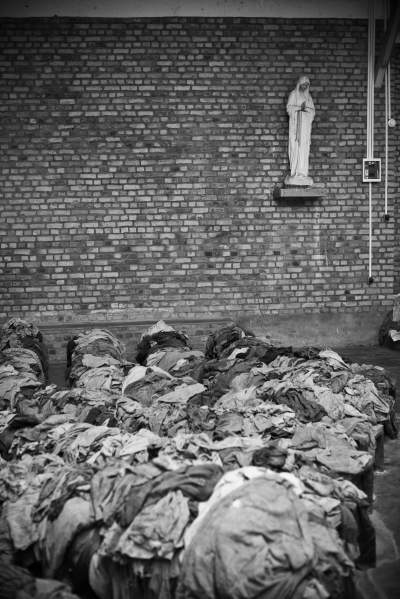Secondary menu
They Live On: Survivors' Narratives of Empowerment 25 Years after the Rwandan Genocide
February 27, 2019
Mehak Kawatra (2L)
"Cheaper than AK-47s or grenades or scud missiles, rape is biological warfare. It not only wounds women in the moment it occurs, but it lodges forever in consciousness, in body, in communities, in families." -- Eve Ensler, December 11, 2008, Afterword to The Men Who Killed Me.
Sexual violence has been used as a gruesome weapon of war for generations. But in a groundbreaking judgment, The Prosecutor v Akayesu (1998), the International Criminal Tribunal for Rwanda recognized that conflict-related sexual violence is an act of genocide. During the 1994 Rwandan genocide, perpetrators used sexual violence as a primary means of ethnic cleansing against the target group. “Rape was the rule, and its absence the exception.”
Through intimate testimonials provided by genocide survivors, The Men Who Killed Me project redefines justice and resilience in the aftermath of the Rwandan genocide. This year, the IHRP team had the opportunity to travel to Rwanda and re-interview some of the survivors featured in The Men Who Killed Me (2009) for its sequel, And I Live On: The Resilience of Rwandan Genocide Survivors of Sexual Violence, set to be released next month. As a clinic student, I had the opportunity to work with the International Human Rights Program, and IMPACT, a Dutch research organization focused on conflict-related sexual violence, to develop the sequel. I helped to prepare and review the survivors’ testimonials, and to develop an introductory chapter focused on the incidence of conflict-related sexual violence in the world.
The Rwandan Genocide
The one hundred days of the genocide against the Tutsi in Rwanda began in April 1994, after an airplane carrying Hutu President Habyarimana was shot down. While the President’s assassination served as the catalyst to the ethnic cleansing of Tutsi, tensions between Hutu and Tutsi were rife long before then. Under the influence of Belgian colonists in Rwanda, the Tutsi minority occupied positions of power and socioeconomic wealth relative to the Hutu majority. Despite cultural similarities between the two groups, the Belgians perceived Tutsi as more European looking than their Hutu counterparts. Through a system of ethnic identification, the colonists granted Tutsi social and economic privilege in society. Decades before the 1994 genocide, stories of conflict were already being written: Hutu extremists, embittered by colonial injustice, targeted Tutsi by robbing their homes, setting their houses on fire, destroying their property, and even murdering them with impunity.
In 1994, in the span of three months, between 250,000 – 500,000 victims were raped or sexually assaulted. Perpetrators of sexual violence included the Hutu militia, the Presidential Guards, military soldiers of the Rwandan Armed Forces, the Rwandan police and civilians, and even French soldiers under a UN-mandated mission to secure a humanitarian area. Women and children of all ages were raped in private and in public, in full view of their loved ones, neighbors, and strangers alike. Their bodies were mutilated, dismembered, and left to rot in the middle of roads, among the bushes or in ditches, and in churches. Tutsi men were not spared; while most were generally murdered, some also suffered brutal sexual violence, sometimes at the hands of female perpetrators. Perpetrators living with HIV raped Tutsi "cockroaches", as Hutu extremists saw them, and sought to intentionally infect victims with the virus as a means of decimating the Tutsi population.

A statue of Mary overlooks victims’ clothing inside the former church at the Nyamata Genocide Memorial. The remains of 50,000 people are buried at the compound. Credit: Samer Muscati.
The Men Who Killed Me: Sequel
The Men Who Killed Me (2009) provides a glimpse into the lived experiences of genocide survivors, 15 years following the genocide. Through their powerful testimonies, 17 survivors shared their stories, detailing the devastating, long-lasting, and intergenerational consequences of genocidal sexual violence. Common themes of social stigma, injustice, poverty, and sickness run through each of these narratives, and reveal unique journeys of survival, justice-seeking, and resilience in the aftermath of the genocide.
Ten years following the release of The Men Who Killed Me, the IHRP, in collaboration with IMPACT, is publishing a sequel, And I Live On. In time for the genocide’s twenty-fifth commemoration, And I Live On shares new testimonials of the same survivors or their surviving relatives. These narratives depict the survivors’ progress over the past decade, as they strive to heal and restore their dignity. They are reflections of empowerment, restoration, and justice in the context of survivorship. In the face of continued sickness, trauma, and poverty, the survivors leave behind legacies from their efforts to rebuild their homes, families, and careers.
Conclusion
In 2019, the Rwandan genocide lives on in the memories of survivors who have since spent nearly 25 years rebuilding their lives. The novelty in the And I Live On project is its emphasis on survivors’ resilience and empowerment instead of victimhood. Their fight for justice is not found in legal proceedings. Rather, it persists in their hearts and minds, as survivors strive to achieve reconciliation and peace for generations to come. In focusing on empowerment and redevelopment, this project does further justice to the victims by shifting the stories from the perpetrators’ acts to the survivors’ enduring responses. These voices live on, to be heard and recognized by a listening world.
